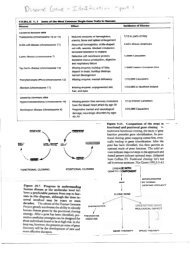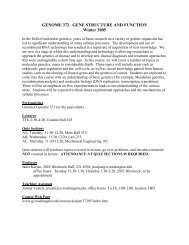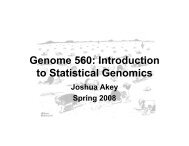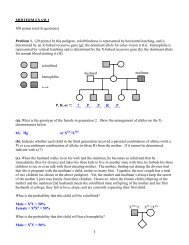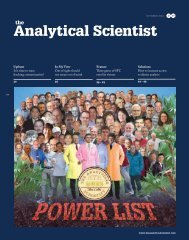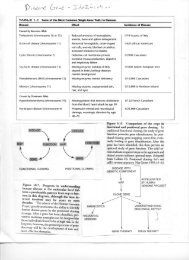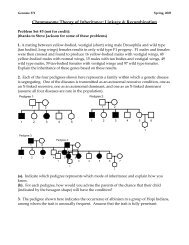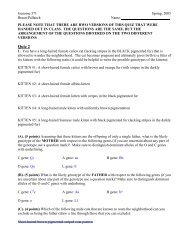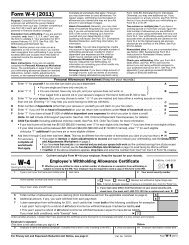Alleles, Phenotype & Genetic interaction
Alleles, Phenotype & Genetic interaction
Alleles, Phenotype & Genetic interaction
You also want an ePaper? Increase the reach of your titles
YUMPU automatically turns print PDFs into web optimized ePapers that Google loves.
Genome 371 Spring, 2005<br />
<strong>Alleles</strong>, <strong>Phenotype</strong> & <strong>Genetic</strong> <strong>interaction</strong><br />
Problem Set #2 (not for credit):<br />
(thanks to Steve Jackson for some of these problems)<br />
1. For each of the terms in the left column, choose the best matching phrase in the right<br />
column<br />
(a). epistasis<br />
(b). modifier gene<br />
(c). conditional lethal<br />
(d). permissive condition<br />
(e). reduced penetrance<br />
(f). mutifactorial trait<br />
(g). incomplete dominance<br />
(h). codominance<br />
(i). Mutation<br />
(j). pleiotropy<br />
1. one gene affecting more than one phenotype.<br />
2. the alleles of one gene mask the effect of alleles of<br />
another gene.<br />
3. both parental phenotypes are expressed in the F1<br />
hybrids.<br />
4. a heritable change in DNA.<br />
5. a trait produced by the <strong>interaction</strong> of alleles of at least<br />
two genes or from <strong>interaction</strong>s between gene and<br />
environment.<br />
6. genes whose alleles subtly alter phenotypes produced by<br />
the action of other genes.<br />
7. less than 100% of the individuals possessing a particular<br />
genotype express it in their phenotype.<br />
8. environmental conditions that allow conditional lethals<br />
to live.<br />
9. the hetrozygote resembles neither homozygote.<br />
10. a genotype that is lethal in some situations (e.g., high<br />
temperature) but viable in others.<br />
2. Explain the difference between epistasis and dominance. How many loci are involved in<br />
each case?<br />
3. A cross between two plants that both have pink flowers produces 80 offspring plants, of<br />
which 38 have pink flowers, 22 have red flowers, and 20 have white flowers. If one assumes<br />
that this variation in color is due to variation at a single locus, what is the genotype<br />
associated with each flower color, and how can you describe the inheritance of flower color?<br />
4. A wild legume with white flowers and long pods is crossed to one with purple flowers<br />
and short pods. The F1 offspring are allowed to self-fertilize, and the F2 generation has 301<br />
long purple, 99 short purple, 612 long pink, 195 short pink, 295 long white, and 98 short<br />
white. How are these traits being inherited?
Genome 371 Spring, 2005<br />
5. Does the nucleotide sequence of a mutation tell you whether it will be dominant or<br />
recessive?<br />
6. (a). If a girl has blood type O what could be the genotype (and corresponding phenotype)<br />
of her parents?<br />
(b). If a girl has blood type B and her mother has blood type A, what could be the genotype<br />
(and corresponding phenotype) of her father?<br />
7. <strong>Alleles</strong> of a gene that determines seed coat patterns in lentils can be organized in a<br />
dominance series: Marbled > spotted or dotted (codominant alleles) > clear. A lentil<br />
homozygous for the marbled seed coat pattern allele was crossed to a lentil homozygous for<br />
the spotted pattern allele. In another cross, a homozygous dotted lentil was crossed to one<br />
homozygous for clear. An F1 plant from the first cross was then mated to an F1 plant from<br />
the second cross.<br />
(a). What are the expected phenotypes of the two F1 plants from the two original parental<br />
crosses?<br />
(b). What phenotypes in what proportions are expected from this mating between the two F1<br />
types?<br />
8. You picked up two mice (one female and one male) that had clearly escaped from<br />
experimental cages in the animal facility. One mouse is yellow in color and the other is<br />
brown agouti. You happen to know that this mouse facility has different alleles at only three<br />
coat color genes: the agouti (A) or non-agouti (a) or yellow alleles (A Y ) of the A gene (A Y<br />
dominant to A and a; A dominant to a), the black (B) or brown allele (b) of the B gene (B<br />
dominant to b), and the albino (c) or non-albino (C) alleles of the C gene (C dominant to c).<br />
The C gene exhibits recessive epistasis to B and A (i.e., cc homozygotes mask the phenotype<br />
of B and A). However, you don’t know which of these alleles are present in each of the<br />
animals that you’ve captured. To determine the genotypes, you breed the animals. The first<br />
litter has only three pups. One is albino, one is brown (non-agouti) and the third is black<br />
agouti.<br />
(a). What alleles of the A, B, and C genes are present in the two mice you caught?<br />
(b). After raising several litters from these two parents, you have many offspring. How many<br />
coat color phenotypes (in total) do you expect to see expressed in the population of offspring?<br />
What are the phenotypes?<br />
9. You do a cross between two true-breeding strains of zucchini. One has green fruit and the<br />
other has yellow fruit. The F1 plants are all green, but when these are crossed, the F2 plants<br />
consist of 9 green to 7 yellow. Indicate the phenotype, with frequencies, of the progeny of a<br />
test cross of the F1 plants.<br />
10. “Secretors” (genotype SS and Ss) secrete their A and B blood group antigens into their<br />
saliva and other body fluids, while “nonsecretors” (ss) do not. What would be the apparent<br />
phenotypic blood group proportions among the offspring of an I A I B Ss woman and an I A I A<br />
Ss man if typing was carried out using saliva?
Genome 371 Spring, 2005<br />
11. A male and female are homozygous, respectively for each of the chromosomes<br />
diagrammed below. You obtain DNA from these individuals, digest the DNA with<br />
restriction enzyme E, and hybridize with the indicated radiolabeled probe:<br />
Probe<br />
E E E E E<br />
100bp 900bp 50bp 150bp<br />
E E E E E<br />
100bp 500bp 400bp 200bp<br />
(a). What pattern of bands would expect to result from your Southern blot analysis DNA<br />
obtained from each of these individuals?<br />
(b). What pattern would you expect to see for the first-born child from the mating of these<br />
two individuals? What about the second-born?<br />
12. One of the genes that control coat color in mice is called agouti. An allele of this gene<br />
producing yellow coat color, A y , is dominant to the normal allele, A + . A second coat color<br />
gene (denoted as C), determines whether any melanin pigment is made. Homozygotes for<br />
the recessive allele (c) have albino coats. From a colleague, you obtain two mice that are<br />
dihybrid for both loci. When crossed together, the phenotypes of their progeny are normal,<br />
albino, and yellow in a 1:1:2 ratio, respectively.<br />
(a). How can you account for this phenotypic ratio?<br />
(b). How could you test this?
Genome 371 Spring, 2005<br />
13. Consider the following pedigree of a completely penetrant trait:<br />
? ?<br />
(a). Describe the genetic characteristics of this trait, including dominant/recessive,<br />
autosomal/sex-linked, common/rare. State your reasons.<br />
(b). If III-6 is homozygous, what proportion of the sons of III-5 will have the trait? What<br />
proportion of his daughters will have the trait?<br />
(c). How would your answer to part A change if the trait was not completely penetrant?<br />
14. The Shepard’s Purse plant produces two kinds of fruit, "heart-shaped" or "narrow". The<br />
shape of the fruit depends on the action of two duplicate (redundant) genes, A and B. When<br />
both genes are homozygous recessive, the fruit has a narrow shape.<br />
(a). If 800 fruit from a dihybrid selfcross are examined, how many will you expect to be<br />
narrow?<br />
(b). What proportion of the plants that have heart-shaped fruit in part A will give only heartshaped<br />
fruit when self-crossed?<br />
15. Two parents, with blood-type genotype iI A and iI B , have seven children.<br />
(a). What is the probability that all seven children will have AB bloodtype?<br />
(b). What is the probability that all seven children will have O bloodtype?<br />
16. The production of substance H, the precursor to the blood type antigens requires a<br />
dominant allele of gene H. The table below shows the responses of blood samples from the<br />
individuals in the pedigree to anti-A and anti-B sera. A “+” in the anti-A row indicates that<br />
the red blood cells (RBCs) of that individual were clumped by anti-A serum and therefore the<br />
individual made A antigens, and a “-“ indicates no clumping. The same notation is used to<br />
describe the test for the anti-B antigens.<br />
I-1 I-2 I-3 I-4 II-1 II-2 II-3 III-1 III-2<br />
Anti-A: + + - + - - + + -<br />
Anti-B: + - + + - - + - -
Genome 371 Spring, 2005<br />
I<br />
II<br />
III<br />
1 2 3 4<br />
1 2 3<br />
1<br />
2<br />
(a). Deduce the blood type of each individual from the data in the table.<br />
(b). Assign genotypes (including H) for the blood groups as accurately as you can from this<br />
data and explain the pattern of inheritance shown in the pedigree.<br />
17. What phenotypic ratios would you expect from crossing triply heterozygous flies if three<br />
genes affect a trait and one dominant allele of each gene is necessary to get a wild type<br />
phenotype?<br />
18. m&ms are a useful model organism for exploring Mendelian inheritance patterns.<br />
(a). For example, suppose the shell locus controls color and filling controls whether the<br />
m&m has a nut or not. Truebreeding blue m&ms crossed to truebreeding red m&ms give<br />
100% purple progeny. Truebreeding peanut m&ms when mated to truebreeding plain<br />
m&ms lead to 100% “halfnut” progeny (the nut fills only one half of the shell, these candies<br />
are not yet available in stores). How do you explain the purple and halfnut phenotypes?<br />
(b). A third locus (crispy) dictates whether the candy has a crispy or normal texture. Assume<br />
that crispy is an X-linked recessive trait and that sex determination of m&ms is like that of<br />
mammals. A crispy m&m male mates with a normal phenotype female. The F1 is made up<br />
of 37 crispy females, 54 crispy males, 46 normal females, and 65 normal males. What is the<br />
genotype of the parent m&ms?<br />
19. A new all-white, true-breeding variety of Snapdragons has been developed by your local<br />
florist. When this variety is crossed to true-breeding red snapdragons, the dihybrids are<br />
white. However, when these dihybrids are self-crossed, the following phenotypes are<br />
observed: 129 white, 21 pink, and 11 red.<br />
(a). What are the likely genotypes of the parents? Define any symbols you use.<br />
(b). Can these results be explained if a homozygous recessive allele of one gene masks the<br />
phenotype of the other gene (recessive epistasis)? Test this hypothesis with a χ 2 test.<br />
(c). Propose a genetic hypothesis for these results that passes a χ 2 test.<br />
20. You have identified two true-breeding varieties of tomato plant, one that gives red<br />
flowers and large tomatoes, and another variety that gives white flowers and small tomatoes.<br />
You proceed to cross the two varieties and observe that the F 1 offspring all produce small<br />
tomatoes and pink flowers. You then self-fertilize the F 1 hybrids and observe the following<br />
number of each offspring:<br />
red, small (43) pink, large (24)
Genome 371 Spring, 2005<br />
red, large (12) white, small (39)<br />
pink, small (79) white, large (11)<br />
(a). Provide a hypothesis that explains the inheritance pattern of the flower color and tomato<br />
size traits (i.e., define the dominance/recessiveness relationships for the flower color and<br />
tomato size traits).<br />
(b). Test your hypothesis for the inheritance pattern of tomato size and tomato plant flower<br />
color using a χ 2 test and calculate the corresponding P value. Does this P value allows you to<br />
accept or reject your hypothesis in (a).<br />
(c). You decide to cross all of the pink-flowered, small F 2 plants to the pure-breeding white<br />
flower, small tomato variety to further test your hypothesis for the inheritance pattern of<br />
flower color. What would you expect from these crosses (in terms of flower color only) given<br />
your proposed inheritance pattern?<br />
21. You have captured a female albino mouse in your home and have decided to keep it for a<br />
pet. A few months later, you catch a male albino mouse while on a camping trip. You<br />
wonder if the two mice are albino due to mutations in the same gene (albino is NOT the<br />
wildtype mouse coat color). What could you do to find out? (assume that the mutations are<br />
recessive).<br />
22. To understand the genetic basis of locomotion in the nemotode C. elegans, you have<br />
carried out a screen to identify mutants exhibiting uncoordinated movement. From this<br />
screen, you have recovered twelve C. elegans mutants (designated 1-12 below) that are<br />
homozygous for recessive mutations causing uncoordinated movement. The twelve mutants<br />
were intercrossed and the progeny of these crosses were examined to determine whether<br />
they exhibit wildtype (+) or uncoordinated movement (-). Results of this analysis are shown<br />
below (the intersection of this matrix represents the outcome of a cross between the given<br />
mutants).<br />
1 2 3 4 5 6 7 8 9 10 11 12<br />
1 - + + + - + + + + + + +<br />
2 - + + + - + - + - + +<br />
3 - - + + + + + + + +<br />
4 - + + + + + + + +<br />
5 - + + + + + + +<br />
6 - + - + - + +<br />
7 - + + + - -<br />
8 - + - + +<br />
9 - + + +<br />
10 - + +<br />
11 - -<br />
12 -<br />
(a). What is the intercrossing experiment designed to test?
Genome 371 Spring, 2005<br />
(b). How many different complementation groups (genes) affecting locomotion have been<br />
identified? How many alleles exists for each of the different complementation groups?<br />
23. In a certain species of flowering plants with a diploid genome, four enzymes are involved<br />
in the generation of flower color. The genes encoding these four enzymes are on different<br />
chromosomes. The biochemical pathway involved is as follows:<br />
White green blue purple<br />
The double arrow indicates that either of two different enzymes is able to convert a blue<br />
pigment into a purple pigment. A true-breeding green-flowered plant is mated with a truebreeding<br />
blue-flowered plant. All of the plants in the resultant F1 generation have purple<br />
flowers. F1 plants are allowed to self-fertilize, yielding an F2 generation. Indicate the<br />
fraction of F2 plants with the following phenotypes: White flowers, green flowers, blue<br />
flowers, and purple flowers.<br />
24. One oak tree cell with 14 chromosomes undergoes mitosis.<br />
(a). How many daughter cells are formed, and what is the chromosome number in each cell?<br />
(b). If the same cell had undergone meiosis, how many daughter cells would have resulted,<br />
and what would have been the chromosome number in each?<br />
25. A system of sex determination known as haplodiploidy is found in honey bees. Females<br />
are diploid and males (drones) are haploid. Male offspring result from the development of<br />
unfertilized eggs. Sperm are produced by mitosis in males and fertilize eggs in the females.<br />
Ivory eye is a recessive characteristic in honey bees. Wild type eyes are brown.<br />
(a). What progeny would result from an ivory-eyed queen and a brown-eyed drone (give<br />
both the genotype and phenotype)?<br />
(b). What would result from crossing a daughter from the mating in (a) with a brown-eyed<br />
drone?<br />
26. (a). What are the four major stages of the cell cycle?<br />
(b). What stages are included in interphase?<br />
(c). What events distinguish G1, S and G2?<br />
27. Somatic cells of chimpanzees contain 48 chromosomes. How many chromatids are<br />
present at:<br />
(a). anaphase of mitosis?<br />
(b). anaphase I of meiosis?<br />
(c). anaphase II of meiosis?<br />
(d). G1 of mitosis?<br />
(e). G2 of mitosis?<br />
(f). G1 just prior to meiosis I?<br />
(g). prophase of meiosis I?



